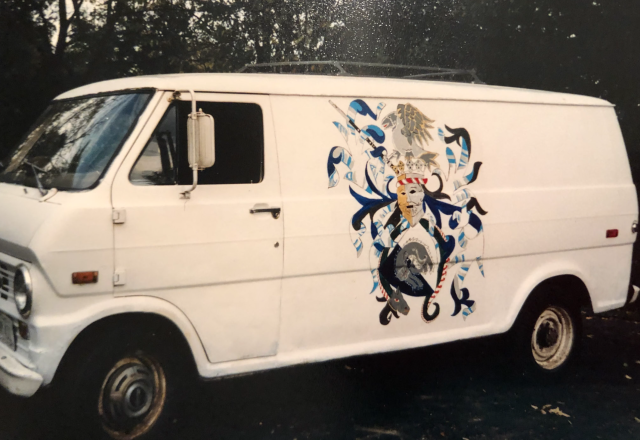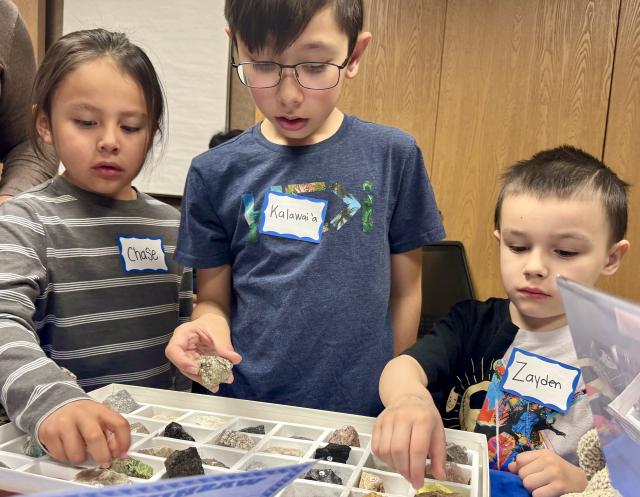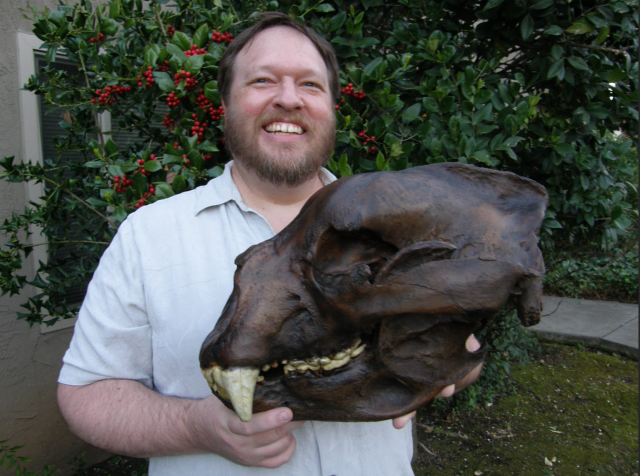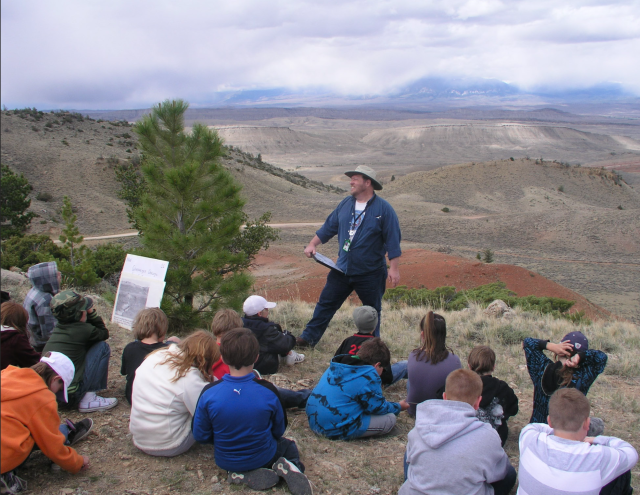You are viewing ARCHIVED content published online before January 20, 2025. Please note that this content is NOT UPDATED, and links may not work. Additionally, any previously issued diversity, equity, inclusion or gender-related guidance on this webpage should be considered rescinded. For current information, visit https://www.blm.gov/blog.
Greg and Cami: A Tale of Two Geologists
Greg Liggett’s path to becoming the Bureau of Land Management Montana/Dakotas State Paleontologist was a bit … rocky. He grew up in Cincinnati, Ohio, and wasn’t quite sure what he wanted to be growing up but knew he had a deep appreciation of science and nature.
He began his scholarly pursuits in the medical field working in a lab in a hospital, but soon realized he preferred being outdoors. He quickly changed paths and enrolled in a surveying program that would allow him to be outside while using his skills in math and geometry.
During this time, Greg started volunteering his time at the Cincinnati Museum Center’s exhibits department, mostly working with ice age sculptures and artifacts. This is the moment when everything clicked for him. “I am at home with this group of people,” he said. He was able to combine his love for the outdoors, anatomy, and engineering and knew this was the path he wanted to take. Greg was invested in helping the museum, and even helped them move locations across town before getting professional advice from the museum’s curator about which university to attend to be able to do similar work.
Not too long after, Greg packed up his windowless van featuring the album art of Jethro Tull’s Crest of a Knave and began the 855-mile journey to Fort Hays State University in Kansas. Rumor has it that he may or may not have been pulled over multiple times for the suspicious nature of his rock-devoted van.

When he walked into the University, little did he know, the first person he saw, a woman working at the front desk “growing out a bad haircut” would not only be his future colleague, but also the love of his life and wife. Cami, now a geologist working in the Solid Minerals Branch, grew up in Hays, Kansas, and knew she wanted to pursue a career in geology when she was only about 7-years-old.
“I fell in love with rocks because they can tell a story,” she said. “I was fascinated by the layers of rock because they are like the pages of a book. When you read those layers, you learn a fantastic story about the continent.”
In true Greg fashion, he still had some difficulty deciding between a degree in Biology or Geology once he arrived at Hays. He thought his former medical credits might be able to transfer over to a biology degree and went to talk to the department before making his final decision. On the way there, he found a small animal bone on the ground that captured his attention. When he arrived at the Biology Department, he knew they would be familiar with anatomy and hoped to get an answer about what kind of bone he found. The Biology Department delivered two layers of unfortunate news. First, they had no idea what bone he was holding, and second, his medical credits would not transfer to their program. Greg then sought out Dr. Nelson, the head of the Geology Department, hoping the program may be a better fit. Even better news, Dr. Nelson immediately identified Greg’s curious bone as a turkey leg, one that was likely discarded after someone finished their lunch.
Greg and Cami were both officially enrolled in the Hay’s Geology program. It would be another few years before he worked up the courage to ask her out on a date though. Partly because Cami was a graduate student and was one of his instructors. As luck would have it, the young geologists both ended up working at a local natural science museum, that just happened to be moving locations. Greg already has experience with a museum move and jumped at the opportunity to contribute. Cami was the museum educator and is still passionate about teaching today. It was their first official job together but would not be the last. After about 10 years at the museum, Greg accepted another job to stand up a new museum in Chico, California. While he headed to the west coast, Cami stayed behind in Kansas for another two years before joining him.


“One of the unique challenges of being married and working together professionally is that it isn’t always easy to find two jobs in the same place at the same time,” Cami said.
Several years later, Greg accepted a job at the Montana/Dakotas State Paleontologist with the BLM in 2012. Cami, again, stayed behind in California for a bit before making her way to Montana and volunteering at the BLM Montana/Dakotas State Office. Soon after, Greg took a detail in Washington D.C. as the National Curator, and Cami continued to volunteer for BLM headquarters while in the nation’s capital, before officially being hired as a Land Law Examiner in 2016.
“I was able to help Cami learn more about the organization’s structure before she came on,” Greg said.
This is only one of the ways they continue to support each other professionally. They also edit each other’s work and often talk about their exciting projects while off the clock. With their years of experience, they have a lot of unique and fun memories to share about their journey as coworkers and spouses.
Cami got to put her passion of teaching to work once again during the 2024 Take Your Kids to Work Day event. Greg and Cami led a geology and paleontology station for kids to learn more about their roles in the BLM. The display featured minerals, rocks, and fossils including a skull of the short-faced bear. The short-faced bear and other megafauna hold a special place in Greg’s heart from his time volunteering in Cincinnati working on an ice age exhibit. The short-faced bear also happens to be one of the first fossils he discovered in the field during a trip to Idaho Falls with his former professor, and turkey-wing identifier extraordinaire, Dr. Nelson. Greg also sports a fresh tattoo of the bear’s skull on his left forearm to commemorate its special meaning in his life.


Some of the rocks on display were agates, and other stones found throughout the Treasure State. While Montana’s agates and sapphires are true beauties, they don’t rank amongst Cami’s favorites. Her favorite rock unit is the colorful Dakota Formation that is present throughout the Great Plains and even on the eastern slope of the Rocky Mountains in Colorado. It is composed of varying layers of sandstone and mudstone. This time transgressive unit has preserved dinosaur footprints and other fossils remarkably well, and represents the shoreline of the former Cretaceous Seaway. Earlier in her career, Cami worked on water quality research, drilling into the layers of the Dakota Formation.
“In Colorado, the layers of the face of the formation are visible on the side of the Rocky Mountains,” she said. “It is incredible to be able to see the same layers I drilled into for research above ground.”
Even now, Greg and Cami continue to volunteer at museums, and have hosted booths at the Dinosaurs & MOR event at the Museum of the Rockies in Bozeman, Montana to help educate the public about the importance of fossils and continued scientific study.
“Public lands are crucial for scientific research,” Greg said. “Fossils found on public lands are owned by the public and are often donated to museums for further research and education. A lot of fossils found on private lands are sold to collectors and are lost to science.”

In the 1990s and early 2000s, Greg was a federal liaison on the Society of Vertebrate Paleontology Committee that helped inform potential legislation to better protect fossils on public lands. About 20 years later, the Paleontological Resources Preservation Act (PRPA) was enacted in 2009 and solidified the cultural and historical significance of fossils, while increasing penalties for stealing specimens from public lands.
“It was a full circle moment when I started working at the BLM and contributed to protecting vertebrate fossils on public lands, in no small part because of the passage of PRPA,” Greg said.
With a life dedicated to public service and an aspiration for continuous learning, Cami and Greg are valued and appreciated at the Montana/Dakotas State Office for the important work they perform every day.
Cami uses her expertise to research and make decisions on applications and claims for land use, minerals leasing, and mining on public lands in accordance with applicable laws and regulations, which is critical for BLM to achieve its multiple-use mission.
Greg is involved with various projects and programs that are helping other states too, like the Recreation and Permit Tracking Online Reporting (RAPTOR) program and he is the Bureau’s lead for the Potential Fossil Yield Classification (PFYC) System, which will help the public and professionals in the field now, and well into the future.
With a whirlwind journey and decades of experience behind them, Greg and Cami are proud of their public service and have a few hopes and aspirations for the future of paleontology in the BLM.
“Paleontology is just as important as archaeology to understand our history,” Greg said. “I hope the paleontology field is able to grow and flourish to aid in the preservation of our incredible historic record.”
Brittany Jones
Related Stories
- Using science to uncover mysteries of the Mesa archaeological site in Alaska
- Agua Fria National Monument: A desert oasis with a rich history and a vital present
- Monument map earns ‘finalist’ honors in global GIS awards
- BLM Fire and National Conservation Lands managers collaborate to meet shared goals
- Virtual adventures await: Discover six BLM public lands you can tour from anywhere
Office
5001 Southgate Drive
Billings, MT 59101
United States
